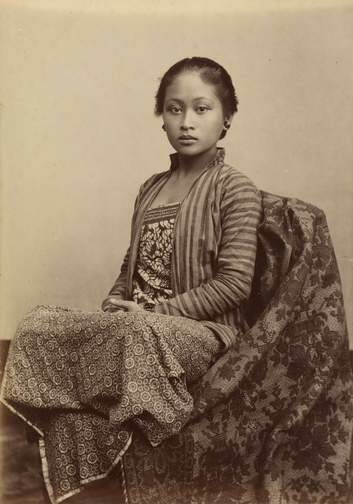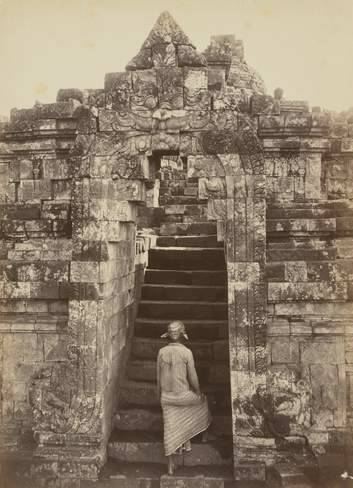Garden of the East: Photography in Indonesia 1850s – 1940s.
National Gallery of Australia, Orde Poynton and Project Galleries.
Until June 22.
Subscribe now for unlimited access.
or signup to continue reading
In 2006, Ron Radford, the director of the National Gallery of Australia, took a bold decision to study and collect the photography of the Asia-Pacific region. It was a bold move because no one else was doing it and no one knew what to expect. Two years later the historically significant exhibition, Picture Paradise: Asia-Pacific Photography 1840s -1940s, was staged at the gallery. It was a show which did not rewrite the history of photography in the region, but produced the first draft of this history. All subsequent studies will be based on that groundbreaking exhibition.

Garden of the East: Photography in Indonesia 1850s - 1940s, belongs to this series of exhibitions, which in over 200 photographs, albums and view books, constitutes the first scholarly and documented history of photography in Indonesia before independence. It covers the period from colonial rule under the Dutch East India Company through to the formation of the modern entity of the Republic of Indonesia in 1945. Most of the names of photographers in this exhibition are unfamiliar to all but a few dedicated scholars and very few images have been in popular circulation.
Almost all of the photographs in this exhibition were acquired from the collection of an Amsterdam-based collector and dealer, Leo Haks in 2007, and now about 5000 photographs from this collection are up on the gallery's website.

What does this exhibition tell us about photography in colonial Indonesia? Firstly, in terms of techniques and styles, Indonesian photography largely followed the developments in Europe and followed them in close succession. Daguerreotypes appeared in Indonesia in the 1840s, shortly after the process was patented in Paris, although few if any are known to have survived with most of the images preserved as copied prints. Dry plate photography led to a proliferation of images. As the cheaper amateur point and snap cameras became available, professional photographers embraced the fashion for pictorialist and picturesque photography, at about the same time as they did in Europe, America and Australia. Modernist photography skirted the edges of the Indonesian experience as the main market lay with capturing likenesses and scenic views.
The second observation is that the most marked differentiating factor in Indonesian photography is the subject matter of the photographs and attitudes and ideologies which they reflected. The ruling sultans wanted to appear as ruling sultans elsewhere, the prosperous Javanese and Chinese sought out images of self which stressed status, but expressed them with a somewhat local accent in terms of dress codes, while spectacular scenes from beauty spots and archaeological antiquities in the sprawling archipelago became the main currency in promoting the image of an exotic paradise on earth.
Of the photographers who emerge in this exhibition, there is less of a personal stamp and more of a studio style. I love the story of how Walter Woodbury and James Page had difficulties in making a splash in Melbourne and went to Batavia (Jakarta) in 1857. They landed on their feet. Their studio produced gorgeous images with a deep rich velvety tonality. Theirs was one of several thriving studios which essentially serviced an expat community and whose images soon had an international distribution.
There are relatively few ''native-born'' photographers, with the Javanese photographer Kassian Cephas the outstanding exception. He began work for the sultan in Yogyakarta in the early 1870s and quickly attained a high social standing and financial success. Many of his images of local people, dancers and customs are devoid of the exoticism tag. The sitters in the photographs seem to ''belong'' in their settings, even if there are studio backdrops, and the dancers and performers appear less consciously posed. It could be simply that they felt less intimidated by being photographed by one of their own.
Large European-operated studios, including the Armenian O Kurkdjian and German CJ Kleingrothe studios, as well as Chinese-owned studios, by the 1890s seem to have cornered the market for official portraiture. By the turn of the century more scenic views were being produced to cater to the burgeoning tourist market, the visits by the new ''grand tourists'' exploring the greener pastures of colonial Asia.
Garden of the East is an extensive exhibition, where you can bring along a packed lunch as you explore this professionally documented show, which presents fresh insights into the life and customs of our nearest Asian neighbour. The exhibition is a triumph of scholarship by Canberra's leading scholar of photography, Gael Newton, and it is with great sadness I note that this is her last major exhibition before she retires from the National Gallery. Gael leaves a huge hole that will be very difficult to fill.

